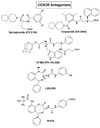Role of CCK/gastrin receptors in gastrointestinal/metabolic diseases and results of human studies using gastrin/CCK receptor agonists/antagonists in these diseases
- PMID: 17584143
- PMCID: PMC2718729
- DOI: 10.2174/156802607780960519
Role of CCK/gastrin receptors in gastrointestinal/metabolic diseases and results of human studies using gastrin/CCK receptor agonists/antagonists in these diseases
Abstract
In this paper, the established and possible roles of CCK1 and CCK2 receptors in gastrointestinal (GI) and metabolic diseases are reviewed and available results from human agonist/antagonist studies are discussed. While there is evidence for the involvement of CCK1R in numerous diseases including pancreatic disorders, motility disorders, tumor growth, regulation of satiety and a number of CCK-deficient states, the role of CCK1R in these conditions is not clearly defined. There are encouraging data from several clinical studies of CCK1R antagonists in some of these conditions, but their role as therapeutic agents remains unclear. The role of CCK2R in physiological (atrophic gastritis, pernicious anemia) and pathological (Zollinger-Ellison syndrome) hypergastrinemic states, its effects on the gastric mucosa (ECL cell hyperplasia, carcinoids, parietal cell mass) and its role in acid-peptic disorders are clearly defined. Furthermore, recent studies point to a possible role for CCK2R in a number of GI malignancies. Current data from human studies of CCK2R antagonists are presented and their potential role in the treatment of these conditions reviewed. Furthermore, the role of CCK2 receptors as targets for medical imaging is discussed.
Figures


References
-
- Ivy AC, Oldberg E. A hormone mechanism for gallbladder contraction and evacuation. Am. J. Physiol. 1928;65:599–613.
-
- Edkins JS. On the chemical mechanism of gastric secretion. Proc. R. Soc. Lond. [Biol] 1905;76:376.
-
- Dufresne M, Seva C, Fourmy D. Cholecystokinin and gastrin receptors. Physiol Rev. 2006;86:805–847. - PubMed
-
- Jensen RT. Involvement of cholecystokinin/gastrin-related peptides and their receptors in clinical gastrointestinal disorders. Pharmacol. Toxicol. 2002;91:333–350. - PubMed
-
- Peter SA, D'Amato M, Beglinger C. CCK1 antagonists: are they ready for clinical use? Dig. Dis. 2006;24:70–82. - PubMed
Publication types
MeSH terms
Substances
Grants and funding
LinkOut - more resources
Full Text Sources
Other Literature Sources
Medical

